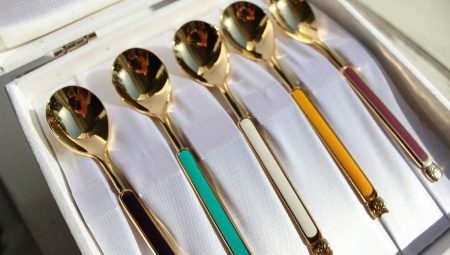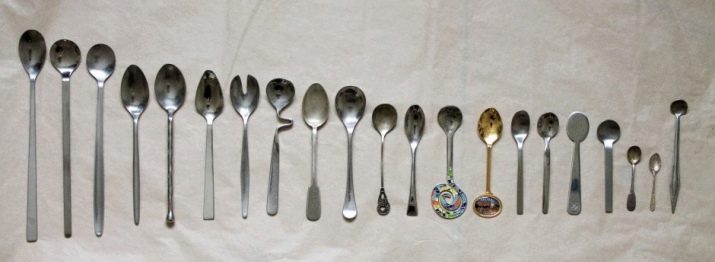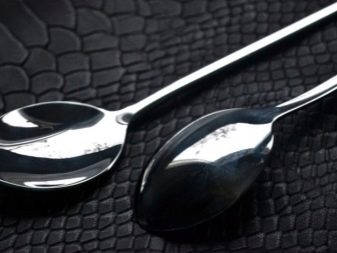Dessert spoons: features and choices

Everyone has heard of the existence of a dessert spoon, but few people know how it differs from others, and how to use it correctly. Let's take a closer look at this device.
Description
In order not to get into a mess when you come to a dinner party, you need to know the purpose of elementary cutlery and imagine how they look.
A dessert spoon, like any other, consists of a scoop, which is smaller than a tablespoon, but larger than a teaspoon, and an elongated handle that is comfortable to hold with three fingers. The devices are decorated with all kinds of patterns, giving them an original shape. For the banal eating of soup or porridge, this device is not suitable.
The dessert spoon is designed for exquisite dishes and all kinds of delicacies - this is also evidenced by its name. It is needed where ice cream, mousses, puddings, creams, sambucas and soufflés are served.

Spaciousness
There are 2 types of dessert spoons - American and English. The second is more familiar to us, its volume is 10 ml. The capacity of the American spoon is larger, but not by much - exactly 1 ml. Dessert spoon size 18 cm.
As for the capacity, then in a dessert spoon you will type:
- 10 ml of water and milk;
- 9 ml of honey;
- 10 ml vinegar;
- 11 ml milk yogurt;
- 14 ml low-fat sour cream.

The amount of bulk products that will fit in a dessert spoon:
- 3 g icing sugar;
- 5 g sugar;
- 6.5 g salt;
- 4 g dry yeast;
- 5 g flour;
- 5.5 g cocoa;
- 4 g of rice;
- 7 g beans;
- 4 g cinnamon;
- 8 g raisins;
- 9 g honey;
- 12 g citric acid.


Varieties
There are many types of dessert spoons. For almost every dessert there is a special spoon, which is convenient to take and eat. The following dishes are used with a special spoon:
- sugar - pick up with a scoop-shaped spoon;
- sauces - eaten with an extended scoop;
- broths - with a deeper and more rounded spoon;
- cocktails and soft drinks - with a long handle;
- ice cream - rectangular, with folded edges and a shortened handle;
- honey is collected with a special wooden scoop in the form of a miniature barrel with slots in diameter;
- olives and olives - with a long handle and a hole in the scoop, from which the marinade flows back into the jar;
- absinthe - a spoon for him is the most unusual, peculiar shape with rectangular ribs and intricate holes, so that it is convenient to put a sugar cube in it and pour cold water, which flows in a thin stream into the drink;
- fruit - for avocado an oval scoop, for kiwi - rounded, and for grapefruit - elongated elongated with jagged edges.

Dessert cutlery is made from a variety of materials.
The simplest ones are disposable plastic ones, for special cases they are made of cupronickel and silver. A set of such spoons with patterned handles and blackened painting - a whole piece of jewelry art - will be a worthy gift for a wedding or anniversary.



There are table setting items made of various materials on sale.
- Wooden. They are used on trips, hikes. They are lightweight, durable, and convenient for eating hot food. Painted wooden spoons are used for interior decoration and as a Russian folk musical instrument.
- Plastic. Lightweight, cheap but short-lived, good for a picnic. Popular in outdoor outdoor cafes: reduce the spread of intestinal infections.
- Aluminum. They were the most common in public catering, but now they are a thing of the past. They have a nondescript appearance, fragile and unsafe for health.
- Made of stainless steel. This is the most common material. Spoons made of it are lightweight, aesthetic and safe.
- Ceramic. Often sold complete with souvenir cups and spice kits.




Difference from other types of spoons
Comparing these items, there are several distinguishing features.
- A dessert spoon is larger than a teaspoon, but smaller than a dining spoon. The difference is as follows: the dining room contains 15 ml of water, and the tea room - 5 ml.
- The length of the cutlery is 20 cm, the tea set is 15 cm, and the dessert one is 18 cm.
- The cutlery is intended for the use of the main hot dishes. A teaspoon, in comparison with others, is used when drinking hot drinks: they stir sugar with it, take jam from a vase. A dessert spoon will be needed at a sweet table along with a dessert fork to taste sweets and delicacies.
- Location on the table. In the universal version of serving, the dessert spoon is placed together with the dessert fork in front of the plate, and the tea and then dining room are placed immediately after the knives on the right side.


How to choose?
Table setting devices can be purchased one at a time or as a set.
It is better to buy spoons in a large retail network. This is a guarantee that you will not buy a product made of some low-quality or even dangerous alloy.
When choosing a product, be sure to pay attention to a number of points.
- The appearance of the spoon. It should be of the correct shape, not have unnecessary thickenings, dents and notches. The drawing should be applied evenly, leaving no marks on the hands.
- Smell. A normal appliance should not have a suspicious smell of paint, metal or plastic.
- The size of the spoon must correspond to the standard: the depth of the scoop is 10 mm, the maximum thickness is no more than 4 mm.
- Decorated and painted spoons have a quality certificate. Be sure to ask if the seller has it in stock.

Spoons made of different metals have their own characteristics, as well as different costs.
Stainless steel
In stores, you can find dishes made of various metals that are not afraid of corrosion, do not darken over time, do not lend themselves to aggressive detergents and have an attractive gloss. These can be devices made of ordinary steel or chromium-nickel alloy.Their price is low.
When buying nickel appliances, remember that this metal can cause severe allergies. If you are prone to this ailment, take a product with a label that guarantees its absence in the composition of the material.
Products made of "space" or "medical" alloy, having super strength and absolute food safety, are distinguished by their high cost.


Of silver
Silver devices have an antiseptic effect. Spoons are always decorated in an unusual and festive way, so they are used for serving on special occasions. It is an expensive pleasure to buy a spoon made of silver by a jeweler, but it is quite possible to purchase it from the manufacturer in a store if desired.
The downside of silver items is the need for careful maintenance.
You should not constantly use a silver spoon: oversaturation of the body with silver ions is undesirable.

From cupronickel
Cupronickel products are more durable and cheaper than silver ones. They are less susceptible to the effects of time, but also need careful care.

Made of plastic
Plastic spoons are made from environmentally friendly, affordable and cheap material. For more than 20 years they have been conquering public catering. They are lightweight, comfortable, and visitors do not take them with them as a souvenir, as their cost is cheap.

Made of wood
The cost of wooden products is low, and environmental friendliness is beyond doubt. Make spoons from linden. Spoons that are not coated with paint and varnish are appreciated, but they are less durable.

From ceramics
The price for ceramics is also low. They are decorative and inconvenient to eat. It is better not to take brightly colored devices: paints may contain lead and copper.


Storage and care
For cutlery to serve for a long time, they need care and proper storage. The main thing is to keep the spoons dry and clean in a separate container or any convenient drawer.
Putting them together with knives and forks is not worth it. The smooth top surface of the instruments will scratch.
This is especially true of silver spoons - this is a very soft material. It is not recommended to store silverware in paper packages and cardboard boxes. The appearance of the products will deteriorate from the sulfur contained in the cardboard. It is better to store holiday appliances in a box or linen bag intended for them.

The rules for caring for cutlery are pretty simple.
- It is advisable to wash spoons immediately after use. They are washed with liquid detergent and a soft sponge. The use of coarse abrasives for products with a glossy metal surface is undesirable.
- A gentle but effective way to gloss: ash, tooth powder, potato starch.
- Phosphoric acid, which is found in carbonated drinks Fanta, Coca-Cola and Sprite, will help to restore the ideal look to the devices. Just leave the cutlery in the soda for a while, then rinse with cold water and wipe dry with a cotton cloth.
- Steel items are dishwasher safe if they do not have plastic handles. Items made of other materials: plastic, wood, precious metals, ceramics - are washed by hand.
- Make sure the spoons are clean before loading them into the machine. Be sure to first remove any food residues on the appliances with a sponge.
- If there are contaminants on the steel spoons in the embossing and decorative recesses, they are removed with a solution of soda and citric acid: for 2 liters of hot water, 2 tbsp. tablespoons of citric acid. The devices are immersed in the composition and left for 20 minutes in a saucepan over low heat.
- So that stainless steel spoons do not have a gray coating, they are washed in a solution: 4 liters of water for 0.4 cups of chlorine bleach. The devices will regain their shine if they are wiped with a cloth soaked in a solution of 10% ammonia and water in a ratio of 1: 9.
- Plastic appliances are thoroughly washed with hot water, but do not boil. Attention is paid to the joints of plastic parts with metal ones. Grease and dirt often accumulate there.
- Cupronickel devices are cleaned with chalk, tooth powder, soft coffee grounds. Can be wiped clean with alcohol or vodka. Products with gilding are recommended to be wiped with wine vinegar or regular egg white.
- After any remedy, the dishes are thoroughly rinsed and wiped dry, otherwise the spoons will darken.
- Silver products are washed with a solution of baking soda, citric acid and sodium chloride. Toothpaste or powder will also help restore the shine to the appliances.
- A regular washing eraser will help remove black deposits from spoons. Rub the darkened areas thoroughly with an eraser, and you will see the shine of silver again.
- Cleans silver gruel from chalk and ammonia: prepare a mixture of 1 part ammonia, 10 parts water and add chalk powder to get the consistency of thin sour cream. Apply the product to a spoon and scrub. There will be no trace of black plaque.


This video will show you how you can decorate a dessert spoon with polymer clay.








